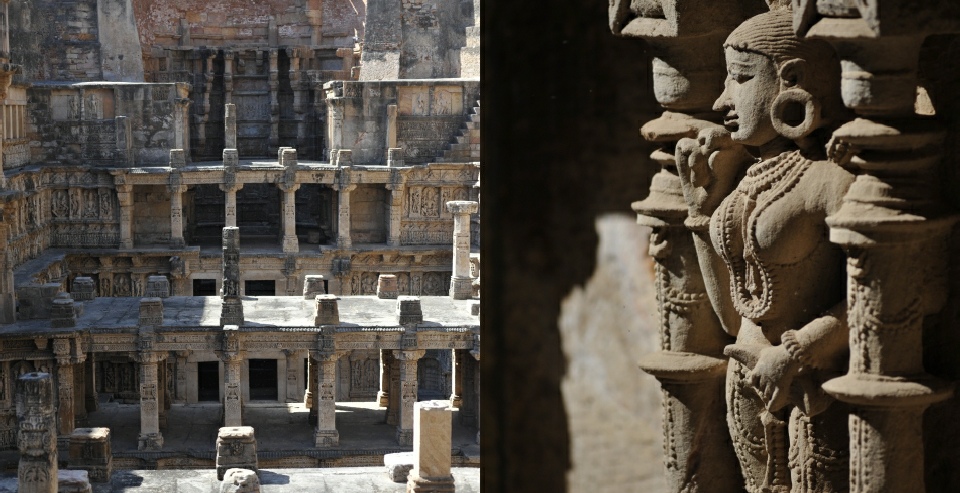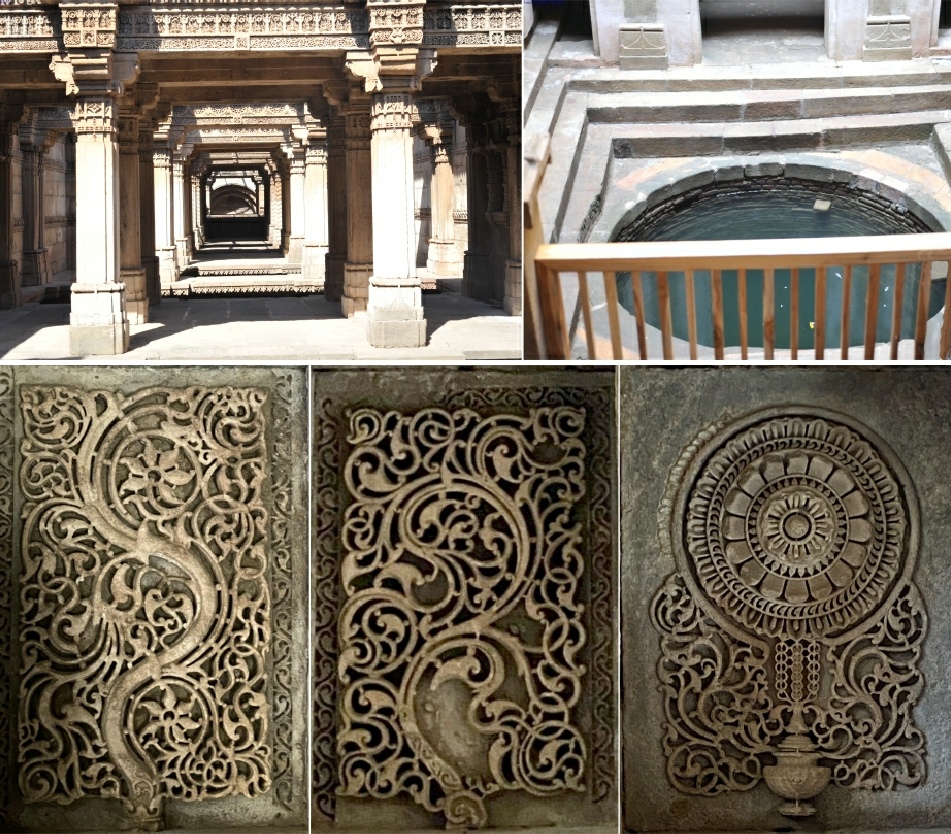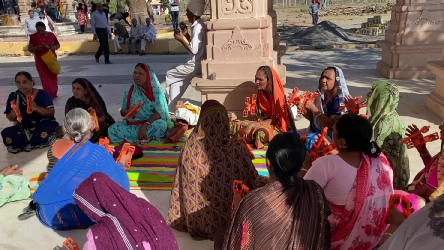
|
પ્રભુ ઇચ્છા |
Ishwar willing |
|
નથી હું સુદામા – થોડો “હેલ્ધી” છું – અને નથી તાંદુળ મારી પાસે, તો દ્વારકા પહોંચવા નું એ પ્રભુ ઇચ્છા એ જ થાય ને! સાહેબ ની ભાણી ના લગ્ન નક્કી થયા, અને ટિકિટ લેવાનું આવ્યું. લગ્ન અમદાવાદ માં હતા, એટલે જરા તુક્કો ઊભો થયો કે ગુજરાત માં બહુ ફર્યા નથી, ખાસ તો પ્રભુ ને મળવા ઓછું ગયા છીએ. અને સો રૂપિયા પર રાણકી વાવ જોઈ, પણ અસલી જોઈ નથી! સાંકડે માંકડું ગોઠવ્યું, અને કેમેરો કાઢ્યો, લેન્સ સાફ કરાવ્યો, બેટ્રી ચાર્જ કરી, અને અમદાવાદ ની ફ્લાઇટ પકડી. લગ્નમાં માહલ્યા, વર રાજા ઘોડે ચઢીને આવ્યા, અને ઘોડાને ચારપાઈ પર ચઢાવી નચાવ્યો – ઘોડાને! ચારપાઈ એટલે સાચ્ચી કાથી ની દોરી વાળી ચારપાઈ! વર રાજો આમ તો સારું એવું ભણેલો છે, પણ બાયોલોજી વાળો એટલે ગણેલો ઓછો! પોતે ઘોડા પર, અને ઘોડો ખટિયા પર! સલામતી ની અક્કલ પણ નાચવા માં મશગૂલ. લગ્ન પરવાર્યા, અને બીજે દિવસે પાટણ જવા નીકળ્યા. બપોરે વાવ જોવા પહોંચ્યા. થોડી ભીડ હતી, અને સૂર્ય પશ્ચિમ જવા માંડે લો. ફોટામાં લાઇટ જોઈએ એટલી સારી નો’તી આવતી, અને બીજા સહેલાણી ઓ ફોટામાં આવે એ ખૂંચતું હતું. ફર્યા, ફોટા લીધા, પણ બીજે દિવસે સવારે સૌથી પહેલ્લાં પહોંચી જવા નો નિર્ણય કરી, પટોળાં ની કારીગરી જોવા નીકળ્યા. સાહેબ ના કાકા ના દીકરા ભાઈએ એના મિત્ર સાથે ગોઠવણી કરેલી, એટલે મૂળ પદ્ધતિ થી વણાતા પટોળાં ના કારીગર ને ત્યાં પહોંચ્યા. જાણ્યું કે પટોળાં વણવાની આવડત મરાઠાવાડા ના જલના નગર ના વણકારો ની પરંપરાગત હતી. પાટણ ના રાજાએ સાળવી નામના વણકારો ના સમૂહ ને પાટણ આમંત્ર્યા – ૭૦૦ વર્ષ પૂર્વે! આજે ફક્ત એકજ સાળવી પરિવાર રહ્યું છે, જે પોતાના બીજા વ્યવસાય ની સાથે સાથે પટોળાં પણ વણે છે – શુદ્ધ પારંપારિક પદ્ધતિ થી, રેશમ ના દોરા થી જ. એમને ત્યાં અમે જિંદગીમાં પહેલી વાર ઢાકા ના મલમલ નો ટુકડો જોયો, જે કહેવાતું કે આખો તાકો અંગૂઠી માં થી પસાર થઈ શકે. સહસ્ત્ર લિંગ તળાવ જોવા ગયા, પણ હવે કંઇ લિંગ કે તળાવ દેખાતું નથી. બીજે દિવસે સવારે પોણા- |
Neither am I Sudama – too plump to show ribs of hunger - My one- Had a good time at the wedding across 3 days and 5 events. The big day saw the bride arrive on horseback, make the horse climb on to a “khatiya” – a rustic bed made of woven coconut strings – and dance with the groom also dancing in the saddle. The groom was well educated, but, safety and animal cruelty were not in the curriculum! The day after saw us take off for Patan and the Rani Ki Vav – known locally as Ranki Vav. We arrived mid afternoon, there was a fair bit of a crowd including a pack of school children. As one may visualise, photography was a challenge, though we did manage a few good ones. The sun was already westerly, so we decided to come back next morning before – hopefully – the crowds arrive. We moved to the SahasraLing water supply complex, but that was a complete disappointment. No water, no lings, impossible to even visualise what it may have been. Next was a Patola weaver’s establishment. Patola is a silk woven fabric of phenomenal complexity of design colour and weaving techniques. It originated in the town of Jalanaa in Marathawada region of Maharashtra. The king of Patan was already a user of this Patola fabric, and about 700 years ago invited a few families of the Salvi clan of Jalanaa to migrate to Patan and set up shop. Now, just one Salvi family follows the time honoured tradition and technique to weave a Patola – 6 to 8 months for a single saree costing between 200 to 500 K rupees – along with heir own other modern vocations. Others have migrated to other yarns, but this family is the only one sticking to the traditional silk. One unusual sight at this museum like establishment was a real piece of Dhaka malmal, a famed fabric of yore from Dhaka (now in Bangladesh) so fine, that an entire bolt of cloth could pass through a ring. Next morning, we were first through the gate, although we did get a scare on seeing three bus loads of school children in the car park. However, inside the Vav, it was just us, and Easterly sun on a bright and clear day and the security staff. This Vav – or stepwell – is the best example ever of a stepwell. There are two pools – not accessible by visitors – fed by underground springs. The water may be visible in the monsoon season, but was too low to be seen in winter. |
|
ત્યાં થી નીકળી અમદાવાદ પાસે અડાલજ ની વાવ જોવા ગયા. અંહી ભીડ તો ભારી, અને એક માથા ભારી “ગાઈડ” મળ્યો જે ઘડી ઘડી માં સાહેબ નો ફોન ઝુંટવી લે અને ફોટો પાડી આપું એમ માથું ખાય. મારી ગાળ ખાતા જરાક બચી ગયો! અડાલજ ની વાવ એક કૂવો છે, જ્યારે રાણકી માં ભૂમિમાં થી સ્ફુરતો ઝરો છે. અહીં છેક પાણી સુધી જવાતું હતું. બની પછી કોઈ નુકસાન થયું નથી એટલે કોતરકરણી સચવાયેલી. ઇતિહાસ એવો છે કે અડાલજ ના રાણા વીરસિંહ એ આ વાવ બાંધવાનું શરૂ કર્યું, કે લોકો ને પાણી મળી રહે. પણ વાવ પૂરી થાય તે પહેલા બાજુ ના પ્રદેશ ના સુલતાને હુમલો કર્યો, અને વીરસિંહ નો વધ થયો. એની રાણી રૂપાબા ઘણી સુંદર હતી અને વિજયી સુલ્તાન એના પર મોહી પડ્યો. રાણી એ વિવાહ માટ શરત મૂકી કે વાવ પૂરી કરાવો. સુલતાને વાવ પૂરી કરાવી - |
On our way back to Amdavad, we stopped to see another stepwell at Adalaj. Better preserved than the Ranki Vav, but smaller, shallower, but more accessible to the water. The pool is actually a well, cordoned off, certainly. But the Vav’s proximity to Amdavad meant many more visitors. We hired a guide, but that irritating fellow kept on grabbing my wife’s phone saying I know the best photo angle for you. That he escaped without being slammed, is credit to my self control. The sculptures are well preserved, although not as prolific as the Ranki Vav ones, because it as been in use since the late 1400's till urbanisation made it a historic heritage. The story is that VirSinh the king of this region started construction as a public service for his subjects. But the Sultan of a neighbouring state attacked him, and Virsinh was killed in battle. His queen was a woman of great beauty, and the victorious sultan was infatuated and proposed marriage. She agreed with a condition that the Vav be completed. The Sultan completed the construction, and called up the promised bethrotal. But the queen wanted to preserve her monogamous vows, and jumped into the well to end her sanctified life. The stepwell has 5 levels, and three entrances, and since it is a well, the water rises dramatically during the monsoon. |

|
અમદાવાદ પાછા આવ્યા, અને રાતે વેરાવળ જતી સોમનાથ એક્સ્પ્રેસ પકડી. વેરાવળ પહોંચ્યા તો સમયસર, પણ આખી રાત સુવાયું નો’તું (બેડિંગ ગંધાતા હતા!) અને એવો વિચિત્ર અનુભવ થયો કે સોમનાથ થી દ્વારકા પણ ટ્રેન માં જવાના હતા એ રદ્દ કર્યું. સોમનાથ ના દર્શન તો સરસ થયા, પણ કેમેરો ફોન બધુ બહાર લોક- બીજે દિવસે ગાડીમાં જ દ્વારકા જવા નીકળ્યા. સોમનાથ માં જ ભાલકા તીર્થ નું મંદિર છે. મંદિર ના આંગણે પીપળા નું વૃક્ષ છે, જે સ્કંદ પૂરાણ પ્રમાણે શ્રી ક્રુષ્ણ ને કોઈ શિકારી નું બાણ વાગતા દેહ ત્યાગ કર્યો એ સ્થાન છે. દ્વારકા જતાં રસ્તામાં માધવપુર નો દરિયો માણ્યો, અને ગંધવી ગામમાં હર્ષદ માતા ના મંદિર પણ ગયા. ત્યાર બાદ દ્વારકા થી કુરંગા ચોકડી પાસે મારી તબિયત બગડી – ઇન્ફ્લુએન્ઝા ની તીવ્ર અસર ઊભરી - પ્રભુ ની ઇચ્છા નો’તી કે અમે દ્વારકા એમને મળીએ એટલે અઠવાડિયું પૂરું થતાં સિંગાપુર ભેગા થઈ ગયા. |
We caught the Somnath Express train that night from Amdavad, and reached Veraval the next morning for a short ride to Somnath, after a thoroughly miserable ride in the train with stinking bed linen and duvet, and equally stinking toilets. Had not slept a wink, and faced the prospect of lugging our bags up and across the foot overbridge! No ramp, no escalator, no lift (which we had at Amdavad!). Went to the temple, checked in all our cameras and cell phones – banned in the temple – into well organised lock boxes – and had “good” darshan. “Good” means no being shoved off from the railing at the inner sanctum – as it happens at crowded temples – and sufficient time in front of the Ishwar to commune with Him! It was Abhishek time, so we glimpsed the Jyotirling in all its glory. The temple was rebuilt / renovated soon after independence at the initiative of Sardar Vallabhbhai Patel, with all the architectural pinnacles covered in donated gold, as was the historical reputation of the temple. Inside was shiny and yellow all over. But, no photos! One disappointment was that the entire temple had been painted over. I mean all temples of India have superb sculptures in every nook and cranny, and the beauty and the artistry resides in the stone and finish of the stone. By painting that over, all that was destroyed – at least for us. Something similar had pained me years ago at the Meenaxi temple in Madurai. We revisited that evening, for an even more elaborate and quiet “darshan” of the Jyotirling decorated for next day’s Mahashivratri festival. A visit to the Triveni confluence – 2 rivers and the sea – closed the day for us. We cancelled the planned train ride to Dwarka, and continued in the car to Dwarka, visiting the Madhavpur beach and the Harshad Mata temple at Gandhavi, but first stop at the edge of Somnath was Bhalka Tirth – where Ska We were at a CNG gas station near Kuranga Chaukadi, when I got hit with severe impact of Influenza I had unknowingly contracted. Night fall saw us headed to Rajkot, and my one- Ishwar did not want to see us in Dwarka, so that is how it was, till the next invite! |



 nd Puraan says Shri Krishna was resting under a Pipal tree, and a hunter’s arrow struck his foot, marking Shri Krishna’s move away from Earth and back to his heavenly abode. There is a Pipal tree in the forecourt of this temple!
nd Puraan says Shri Krishna was resting under a Pipal tree, and a hunter’s arrow struck his foot, marking Shri Krishna’s move away from Earth and back to his heavenly abode. There is a Pipal tree in the forecourt of this temple!